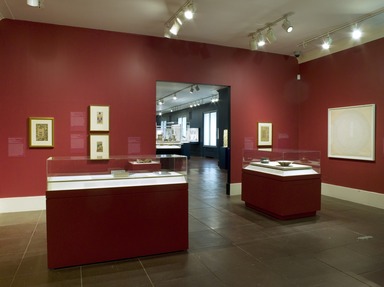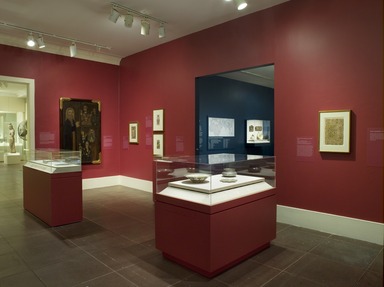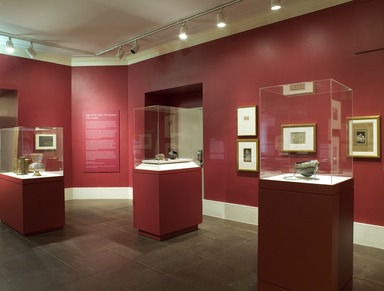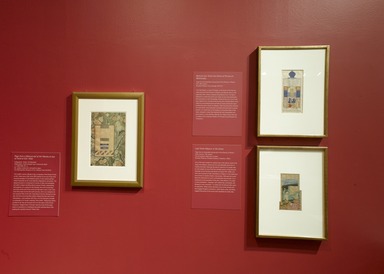

Light of the Sufis: The Mystical Arts of Islam, June 5, 2009 through September 6, 2009 (Image: DIG_E2009_Light_of_the_Sufis_01_PS2.jpg Brooklyn Museum photograph, 2009)

Light of the Sufis: The Mystical Arts of Islam, June 5, 2009 through September 6, 2009 (Image: DIG_E2009_Light_of_the_Sufis_02_PS2.jpg Brooklyn Museum photograph, 2009)

Light of the Sufis: The Mystical Arts of Islam, June 5, 2009 through September 6, 2009 (Image: DIG_E2009_Light_of_the_Sufis_03_PS2.jpg Brooklyn Museum photograph, 2009)
Light of the Sufis: The Mystical Arts of Islam
DATES June 5, 2009 through September 6, 2009
ORGANIZING DEPARTMENT
Special Exhibition
COLLECTIONS
Arts of the Islamic World
-
Light of the Sufis
God is the light of the heavens and the earth; the likeness of his light is as a niche wherein is a light (the light in a glass, the glass as it were a glittering star). . . . Light upon Light! God does guide whom he will to his light. . . .
(Qur’an 24:35)
Light, both literal and metaphorical, figures prominently in Islam, first appearing as a description of God in the Qur’an’s Surāt al-Nūr (The Light Chapter), quoted above. As early as the twelfth century, these verses were given a mystical interpretation by the Sufi philosopher al-Ghazzali (1058–1111), who equated God with light; and by the Iranian mystic Shihabuddin Suhrawardi (1155–1191), who believed God is the source of constant illumination that brings all things into existence and from which all things are derived.
Some of the greatest expressions of light symbolism came through the carefully planned lighting programs of mosques and religious complexes, where beautifully crafted gilded and enameled lamps were suspended from the ceiling to reflect brilliant light off one another. Inlaid metal candlestick bases, often decorated with iconography or inscribed with mystical verses related to light, illuminated the space from below. -
The “Light” in Sufi Literature
The interpretive and metaphorical freedom associated with poetry makes it an ideal instrument for the expression of Sufi philosophy; the most extraordinary examples appear in Persian literature of the medieval period. Poetry provided unlimited possibilities for interplay between sacred and profane images. The Persian language, in particular, which historically has lent itself to music and metaphor, provided poets with an ideal vehicle through which mystical themes such as light, love, and beauty could be explored. Love of God, for example, was often introduced through human relationships. Beholding the beloved—who was considered a reflection of God’s love and the earthly manifestation of divine beauty—could lead to religious ecstasy.
Most of the objects in this section consist of manuscripts or manuscript pages that combine both well-known and more obscure Sufi texts with extraordinary illuminations or illustrations. Also displayed are two works that offer later interpretations of Sufi literature in other media. -
Sufi Inspiration in the Visual Arts
Although manuscripts and albums have historically served as the medium for the interpretation and transmission of mystical texts, many extant portable objects and architectural elements demonstrate the wide range of Sufi artistic inspirations. This final section offers a sampling of the innumerable visual arts in other forms that have reflected the “light of the Sufis” from its inception to the present day. -
Light of the Sufis: The Mystical Arts of Islam
Sufism, or tasawwuf, is generally defined as Islamic mysticism. Its roots lie in orthodox Islam, but Sufism does not come with a clear-cut prescription for practicing the faith. Followers believe the best way to understand it is through the wisdom of one’s own heart. Known as Sufis, they seek tawḥīd, or oneness with God, a mystical union that brings enlightenment through the chance to know God on an intimate level, ultimately surrounding the believer with divine light.
The origins and development of Sufism are unclear, but the movement became well established in the ninth and tenth centuries. At that time, different Sufi orders were formed, led by spiritual advisers or masters, and a more institutionalized ideology encouraged communal practices. Sufism reached its height in the twelfth and thirteenth centuries under the influences of mystics from the Arab, Iranian, and Indian lands; some mystics were considered heretical, while others’ ideas were more widely accepted by orthodox Islam.
Over time, Sufism’s indefinable nature has been demonstrated by its continual evolution and diffusion over a vast geographical area that now includes the Western Hemisphere. From its inception, Islamic mysticism recognized and drew from the traditions and practices of other faiths and cultures with which it came into contact, adapting and incorporating elements of Greek philosophies, Christian mysticism, Judaism, Zoroastrianism, Manichaeism, and Buddhism. The integrative, inclusive (all followers are viewed as equal), and fluid nature of Islamic mysticism gives it broad appeal.
Sufism inspired and continues to inspire some of the finest literature, music, performance, and visual arts in the Islamic world. In these artistic expressions, certain themes abound, including love, beauty, wine, and, especially, light—the “light of the Sufi” that is simultaneously enlightenment and the divine. The objects in this exhibition, representing both literal and figural expressions of important Sufi ideas and practices, reflect the wide impact of Sufism on the arts from the early period to the present day.
Ladan Akbarnia,
Ph.D. Hagop Kevorkian Associate Curator of Islamic Art -
The Sufi Mystic
In addition to “Sufi,” the follower of Sufism is referred to as a darvīsh (dervish; Persian for “poor”) or simply as a Muslim mystic. “Sufi” appears to have been derived from the Arabic word sūf, which may refer to the coarse woolen robe worn by the early practitioners of Islamic mysticism. This simple garment represented their renunciation of worldly goods and aspirations, an act of self-annihilation that constitutes an important step along the Path toward enlightenment. The main stages of that Path include repentance, trust in God, and poverty, which may then lead to contentment, the different degrees of love, or self-knowledge. Once a Sufi sets out on the Path, he or she will be led by an inner light that grows stronger with the removal of each layer of the material and transient world. This process of purification is accompanied by prayer and dhikr, a rigorously disciplined practice of remembering God through the repetition of and meditation on his name or other sacred phrases. The traveler on this Path relies on the guidance of a spiritual master known as a shaykh, murshīd, or pīr.
The development of Sufism into various orders in the twelfth century is believed to have inspired Sufi poetry, as well as rituals involving music and dance that arouse a state of ecstasy as part of the quest for divine union. Sufi orders had distinct traditions and ceremonies, and could be identified by their attire as well as other attributes. For all Sufis, the model in dress and practice was and remains the prophet Muhammad, who is considered to have certainly achieved tawhīd.
-
April 1, 2009
Light of the Sufis: The Mystical Arts of Islam features twenty-four objects from the Brooklyn Museum, The Metropolitan Museum of Art, and private collections that are related to a mystical form of Islam known as Sufism. This special installation will be on view in the Brooklyn Museum’s Islamic galleries from June 5 through September 6, 2009.
While diverse Muslim sects and Islamic cultures do not necessarily share a singular view or practice of Islam, the mystical and romantic nature of Sufism tends to have a more universal appeal to Muslims and non-Muslims alike. This exhibition focuses on some of the most important Sufi ideas and practices that found expression through the arts of the Islamic world, beginning with light, which symbolizes both God and enlightenment. The works displayed represent both literal and figural reflections of important mystical themes, including furnishings used for lighting; representations and attributes of Sufi mystics; illustrated, illuminated, and laser-etched manuscripts of Sufi poetry; and traditional and contemporary works inspired by Sufi principles. The range of chronology, cultures, and media of the works exhibited reflects the wide appeal and impact of Sufism on the arts from the early period to the present day.
Highlights include a gilded and enameled glass lamp inscribed with the famous “Light Verse” (Ayat al-Nur) from the Qur’an, a gilded and jewel-encrusted silver beggar’s bowl meant for collecting alms, and two inlaid brass candlestick bases from the eastern Islamic world made in the thirteenth and sixteenth centuries, respectively. Two contemporary artworks will be featured in this installation: one is a modern interpretation of the mystical verses of the renowned poet Jalal al-Din Rumi (d. 1273), translated by Zahra Partovi and inscribed in a glass book by Brooklyn artist Kelly Driscoll, and the other is a composition of charcoal prayer-stone rubbings by Iranian-American artist Pouran Jinchi. The exhibition will also present several portraits of Sufi dervishes, some identified through inscriptions and others through costumes representing a particular Sufi order. A vintage photograph depicts a dervish family from the early twentieth century in modest attire, while an album page shows a mystic resembling a Chinese luohan in meditation accompanied by his flute and alms bowl. Some works, such as a large Qajar painting and illustrated manuscript pages, illustrate narratives recounted in well-known Sufi literature. Poetry also appears on a beautiful medieval Iranian ceramic dish painted in light-reflecting luster, including verses by Rumi’s master, Shams al-Tabrizi (d. 1248), whom Rumi compared to a sun shining the light of God upon him.
The exhibition has been organized by Ladan Akbarnia, Hagop Kevorkian Associate Curator of Islamic Art, Brooklyn Museum.
Light of the Sufis: The Mystical Arts of Islam will be presented in conjunction with Muslim Voices: Arts and Ideas, an unprecedented ten-day festival and conference in New York City celebrating Islamic culture of which the Brooklyn Museum is a supporting partner.
Press Area of Website
View Original















